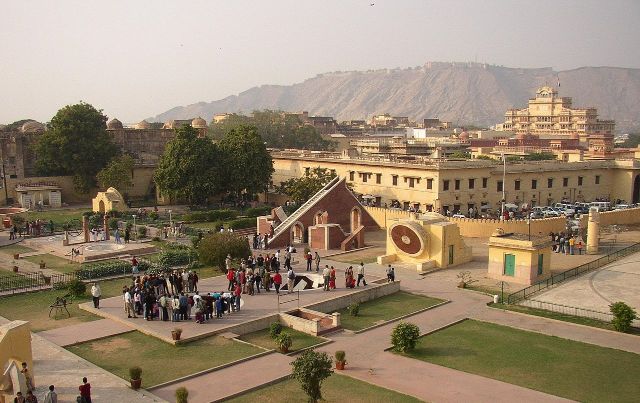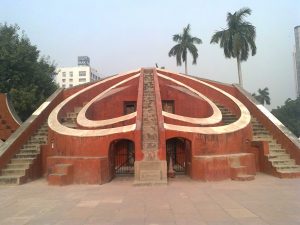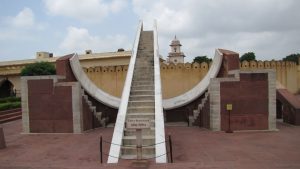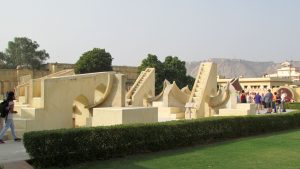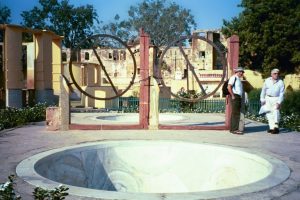Among the most famous of the Kachwaha rulers was Maharaja Sawai Jai Singh II (1688–1743) was the Hindu Rajput ruler of Amer & founder of Jaipur. He became ruler of Amber at the age of 11 initially served undr Mughal, but Later Overthrew the Mughal Rule & built several Hindu Mandirs, Dharmshalas in diff Hindu Pilgrims across the country.Jai Singh II was a True Kshatriya and Dharmik King, He was Termed as 'The Most Enlightened King of India of 18th Century' by French Theologists due to his great interest and Knowledge in Science, Astronomy, Mathematics and Architecture. The armed strength of Jai Singh had always made him, the most formidable ruler in Northern India & all the other Rajas looked up to him for protection & promotion of their interests. Jai Singh increasd the size of his ancestral kingdom by annexing lands from the Mughals & rebels.Sawai Jai Singh was the 1st Hindu ruler in centuries to perform the ancient Vedic ceremonies like Ashwamedha & Vajapeya Yagya (1734) on both occasions vast amounts wr distributed in charity. Making him a true descendant of Lord Ram 4 reviving the great tradition of his ancestors. It was at Jai Singh's insistence that the hated jaziya tax, imposed on the Hindu population by Aurangzeb (1679), was finally abolished by the Emperor Muhammad Shah in 1720. In 1728 Jai Singh prevailed on him to also withdraw the pilgrimage tax on Hindus at Gaya. He Built 5 astronomical observatories at Delhi, Mathura, Benares, Ujjain, & Jaipur. His astronomical observations were remarkably accurate. Its surprising that in the midst of local wars, foreign invasions, and consequent turmoil, He found time and energy to build such structures He drew up a set of tables, entitled Zij Muhammadshahi, to enable people to make astronomical observations. He had Euclid's "Elements of Geometry" translated into Sanskrit as also several works on trigonometry, and Napier's work on the construction and use of logarithms. The observational techniques & instruments usd in his observatories were also superior 2 those used by the European Jesuit astronomers he invited to his observatories. He built Samrat Yantra to estimate the local time, 2 locate the Pole Star, and declination of celestial objects. Jai Singh's greatest achievement was construction of Jaipur city, the 1st planned city of modern times. Built on the ancient Hindu grid pattern, found in the archaeological ruins of 3000 BCE. Merchants wr called 4m all over India settled down in the safety of this rich city. He was one of the greatest Social Reformers of his times, who worked for abolition of Sati, dowry system and curbing the wasteful expenditures in weddings. Such a far sighted Honourable man he was, who could think of such social evils and work on them in that era of turmoil. Sawai Jai Singh(1688-1755) was a very devout Hindu. In Mathura and Vrindavan he purchased private lands to construct dharmashalas and ghats. He also got Mughals remove tax on bathing at Prayah and Sangam. Can u believe this? Hindus couldn't evn Bath Freely @ their religious sites Sawai Jai Singh II founded fortified townships called Jaisinghpuras, at almost all Hindu religious centres in northern India, including at Rama Janmasthan, to restore Hindu dharma. The map of Ram Jamabhumi, was in possession of Jaipur Royal Family & given to court in 1991. When asked 4 the ownership of temple land, The Royal Family maintained a stand that they have donated this Land for the Pride of Hindus & won't claim a stake on the Land.Finally, the dream that Sawai Jai Singh had, is being fulfilled, all coz of sacrifice of Lakhs of Devotees.
Jaziya Tax was Reimposed for the 3rd time by Mughals in 1720.
Sawai Jai Singh the Kacchwaha Ruler of Amer, a devout Hindu himself apposed the tax & called on Muhammad Shah & Jaziya was abolished.
In 1728 Jai Singh he led to abolition of pilgrimage tax on Hindus at Gaya as well.
Until, 1721, all the Temples, Maths, Dharmshalas of Hindus after the Death of the Mahant were overtaken by the Mughal Authorities.
Sawai Jai Singh protested against this erroneous act against Hindus and the Practice was abolished by Mughal Emperor.
1. Mughal Religious Policies The Rajputs And The Deccan by Satish Chandra
2. Rajasthan Through the Ages by RK Gupta
3. Mughal Religious Policies The Rajputs And The Deccan by Satish Chandra
Sawai Jai Singh II was a Dharmatma King & Devout Hindu, who constructed Mandirs, Ghats & Dharmshalas across all Major Hindu Pilgrims of India. He also forced Mughals remove tax on bathing at Prayag and Sangam.
Jai Singh founded several small, fortified townships, called Jaisinghpura at almost all important Hindu religious centres in northern India, such as Mathura, Vrindavan, Kashi-Banaras, Prayaga-Allahabad, Ujjain and Ayodhya, in a bid to restore Hindu Dharma.
Sawai Jai Singh was the 1st Hindu ruler in centuries to perform the ancient Vedic ceremonies like the Ashwamedha (1716) and the Vajapeya (1734) yagyas on both occasions vast amounts were distributed in charity.
“Sawai Jai Singh of Jaipur saved the wives of Guru Gobind Singh ji: Mata Sundari & Mata Devi and gave them a handsome allowance for their subsistence.”
Being in Nimbarka Vaishnava Sampradaya he promoted Sanskrit learning and initiated reforms in Hindu society like the abolition of Sati and curbing the wasteful expenditures in Hindu weddings.
It was due to Jai Singh's efforts, the Demonous jaziya tax, imposed on the Hindu population by Aurangzeb (1679), was finally abolished by the Emperor Muhammad Shah in 1720.
In 1728 Jai Singh prevailed on him to also withdraw the pilgrimage tax on Hindus at Gaya. Sawai Jai Singh formed an alliance with States of Mewar and Marwar, against Mughals and Finally Overthrew the Mughal Supremacy, and almost whole of Rajasthan revolted against Mughals and was free from Mughal Domination.
A Dharmatma and a Great King like Sawai Jai Singh II. His astronomical, mathematical and scientific innovation were breakthrough for Indic knowledge in 18th century.
Jantar Mantar Jaipur is an astronomical observatory located in Jaipur, Rajasthan. The construction of Jantar Mantar was built by Sawai Jai Singh from 1626 to 1734, it is included in UNESCO’s World Heritage List.
The Jantar Mantar is a collection of 19 architectural astronomical instruments built by the Rajput king Sawai Jai Singh.
Which features many instruments along with the world's largest stone sundial
Vrihat Samrat yantra is sundial that can give local time to accuracy of 2 seconds
List Of Instruments:
Samrat Yantra - Monarch machine
The largest Yantra in Jantar Mantar is Samrat Yantra. Due to its grandeur and vastness, it was called Samrat Yantra. The grandeur of the device is gauged from the fact that its top height is 90 feet from the ground. The emperor also has an umbrella at the top. This Yantra was established for revolution, equinox and time knowledge of planetary constellations. it measures time to a precision that had never before been achieved.
Jai Prakash Yantra - May well be Jai Singh’s most elaborate and complex instrument, See the time lapse video above to see how the Kappala Yantra tracks the sun’s movement.
Rama Yantra
consists of a pair of cylindrical structures,open to the sky, each with pole at the center.
In the early 18th century, Maharaja Jai Singh II of Jaipur constructed five Jantar Mantar in total, in New Delhi, Jaipur, Ujjain, Mathura and Varanasi; they were completed between 1724 and 1735.
The Jantar have like Samrat Yantra, Jai Prakash, Ram Yantra and Niyati Chakra;
The pillar & walls are of equal height,which is also equal to the radius of the structure. Those walls inscribed with scales indicating angles of altitude and azimuth.
Each of which are used to for various astronomical calculations. The primary purpose of the observatory was to compile astronomical tables and to predict the times and movements of the sun, moon and planets.
List Of Instruments:
Samrat Yantra
Jai Prakash Yantra
Disha Yantra
Rama Yantra
Chakra Yantra
Rashiwalay Yantra
Dingash Yantra
Utaansh Yantra
Description
Jantar Mantar deploys all three ancient coordinate systems of the five celestial coordinate systems known. In the image, the red (ecliptic) and blue (equatorial) coordinate systems are two of the three classical systems that feature in the monument's instruments
1. Chakra Yantra - Cycle machine
These instruments, made of two huge circles of iron, used to measure the magnitudes of the celestial bodies and the geographical directors of the instantaneous. It is located to the north of the zodiac instruments. (4 semicircular arcs on which a gnomon casts a shadow, thereby giving the declination of the Sun at four specified times of the day. This data corresponds to noon at 4 observatories around the world (Greenwich in UK, Zurich in Switzerland, Notke in Japan and Saitchen in the Pacific); this is equivalent of a wall of clocks registering local times in different parts of the world.)
2. Detector mural - To the east of the Unnatansh Yantra is Dakshodat Bhatiyantra, a walled building extending from the north to south ends. In the front part, there are steps on both sides from the middle of the wall which leads to the upper part of the wall.
While the back of the wall is flat. This device used to know the advancement of the sun and the sun revolution and daylight etc. during the middle time. Dakshin Bhitti Yantra (measures meridian, altitude and zenith distances of celestial bodies)
3. Digamsha Yantra (a pillar in the middle of two concentric outer circles, used to measure azimuth of the sun, and to calculate the time of sunrise and sunset forecasts)
4. Direction machine - Disha Yantra
It is a simple device. In the Jantar Mantar Campus, a large square plane in the middle has a huge circle made of red stone and a right cross is made in all four directions from the center. It is a direction machine that gives knowledge of directions in general.
5. Dhruva Darshak Pattika - Pole plate
Dhruvdarsha is a simple device used to know the position and direction of Dhruva stars. The wall is facing north to south direction, this plate is raised from south to north respectively. By looking at its southern tip, the position of the polaroid at the northern end is clear.(observe and find the location of pole star with respect to other celestial bodies)
6. Jai Prakash Yantra - (two hemispherical bowl-based sundial with marked marble slabs that map inverted image of sky and allows the observer to move inside the instrument, measures altitudes, azimuths, hour angles, and declinations)
Jayaprakash Yantra ‘A’ and Jayaprakash Yantra ‘B’
Jai Prakash instruments were invented by Maharaja Jai Singh himself. The shape of these bowl-shaped instruments is unmatched. These instruments are located between the Samrat Yantra and Disha Yantra in the Jantar Mantar complex.
In these, the astronomical orientation of half the astrophysics was considered as the horizon and for the knowledge of every substance. Also, the location of Sun in any zodiac sign is also known by these instruments. These two instruments are complementary.
7. Kapali Yantra - (measures coordinates of celestial bodies in azimuth and equatorial systems, any point in sky can be visually transformed from one coordinate system to another)
8. Kanali Yantra
9. Kranti Vritta Yantra (measures longitude and latitude of celestial bodies)
10. Laghu Samrat Yantra - Mini monarch machine
The Miniature Monarch Yantra is a device located to the west of the Dhruv audience plate. It is also called the sunshine clock. Local time is accurately calculated with this device. This Yantra made of red stone is only a short form of the Samrat Yantra, hence it is known as a miniature instrument.
(the smaller sundial at the monument, inclined at 27 degrees, to measure time, less accurate than Vrihat Samrat Yantra)
11. Misra Yantra (meaning mixed instrument, it is a compilation of five different instruments)
12. Nadi Valaya Yantra - Umbilical cord machine
This device is located on the right side of the entrance. It is divided into two circular faces. The position of the sun and local time can be accurately estimated from the various lines shown around it from its focal point.(two sundials on different faces of the instrument, the two faces represent north and south hemispheres, the accuracy of the instrument in measuring the time is less than a minute)
13. Palbha Yantra
14. Rama Yantra (an upright building used to find the altitude and the azimuth of the sun)
15. Rashi Valaya Yantra - Zodiac ring machine
Their number is 12 indicating 12 zodiac signs. The special feature of these twelve instruments, showing the location of each zodiac sign and the planetary constellations in them, is their design.
All these instruments are similar in view, but the design of these instruments is different, indicating the position of the zodiac signs in the sky.(12 gnomon dials that measure ecliptic coordinates of stars, planets and all 12 constellation systems)
16. Shastansh Yantra - Rest machine
The Shanthas Yantra is a part of the Samrat Yantra. This annular device is located in the shape of the moon in the east and west directions from the base of the emperor. This Yantra was also used to know the position and degrees of planets and constellations. (next to Vrihat Samrat Yantra,this instrument is a 60-degree arc built in the meridian plane within a dark chamber. At noon, Sun's pinhole image falls on a scale below enabling the observer to measure the zenith distance,declination,& the diameter of the Sun)
17. Elevation machine
Just to the left of the entrance of Jantar Mantar, a huge circular circle of metal hanging between two pillars on either side of a circular platform is known as Unnantham Yantra. This instrument was used to measure the elevation and angular height of the object in the sky. Unnatamsa Yantra (a metal ring divided into four segments by horizontal and vertical lines, with a hole in the middle; the position and orientation of the instrument allows measurement of the altitude of celestial bodies)
18. Vrihat Samrat Yantra (world's largest gnomon sundial, measures time in intervals of 2 seconds using shadow cast from the sunlight)
Among the instruments here, ‘Samrat-yantra’ (which is a huge solarium), ‘Jayaprakash-yantra’ and ‘Rama-yantra’ are the most famous, of which ‘Samrat-yantra’ is the highest (about 90feet from the earth). , Through which time can be told with sufficient accuracy.
Major instruments stationary in Jantar Mantar
19. Yantra Raj Yantra (a 2.43-metre bronze astrolabe, one of the largest in the world, used only once a year, calculates the Hindu calendar)
The instruments r in most cases huge structures.
The scale to which they have been built has been alleged to increase their accuracy
However,the penumbra of the sun can be as wide as 30 mm,making the 1mm increments of the Samrat Yantra sundial devoid of any practical significance, Additionally, the masons constructing the instruments had insufficient experience with construction of this scale, and subsidence of the foundations has subsequently misaligned them.
The samrat yantra, for instance, which is a sundial, can be used to tell the time to an accuracy of about two seconds in Jaipur local time.
The Giant Sundial, known as the Samrat Yantra (The Supreme Instrument) is one of the world's largest sundials, standing 27 metres tall.
Its shadow moves visibly at 1 mm per second, or roughly a hand's breadth (6 cm) every minute, which can be a profound experience to watch.
These major instruments in this observatory, which are helpful in measuring time, predicting eclipses, knowing the speed and position of a star, knowing the problems of planets in the solar system, etc.
Looking at these machines shows that the people of India had such deep knowledge of complex concepts of mathematics and astronomy.
Jantar Mantar is an astonishing medieval achievement associated with the old palace ‘Chandramahal’ in Jaipur.
The construction of this unequaled observatory, famous worldwide for analyzing and accurately predicting astrological and astronomical events through ancient astronomical instruments and complex mathematical structures.
The founder of Amer, King Sawai Jai Singh (II) started it in 1728 under his personal supervision, which was Was completed in 1734.
Maharaja Jai Singh II (3 November 1688 – 21 September 1743)
had a great interest in mathematics, architecture and astronomy. He commissioned the Jantar Mantar observatories at multiple places in India, including his capital Jaipur. Before the construction of this observatory, Sawai Jai Singh had sent his cultural envoys to many countries of the world, and had asked for manuscripts of ancient and important texts of astronomy from there and preserved them in his pothikhana and got them translated for his study. Maharaja Sawai Jai Singh II built five observatories across the country on the basis of Hindu astronomy.
These five observatories were built at followig cities:-
1. Delhi,
2. Mathura (in his Agra province),
3. Benares,
4. Ujjain (capital of his Malwa province),
5. and his own capital of Jaipur.
Benaras
Manmandir Ghat, surmounted by the Man Mandir, a palace built by Maharaja Man Singh of Amber. Built before 1585 C.E. It is the oldest building in Varanasi.
Incidentally, it was in this place that Sawai Jai Singh constructed Jantar Mantar Observatory in 1737 C.E.
Incidentally, it was in this place that Sawai Jai Singh constructed Jantar Mantar Observatory in 1737 C.E.
Even in the midst of local wars Sawai Raja Jai Singh II found the time to build five observatories:
New Delhi
First Maharaja Sawai Jai Singh (II) built the emperor Yantra in Ujjain, followed by the Observatory (Jantar Mantar) in Delhi and Jantar Mantar in Jaipur ten years later. He took the help of eminent astronomers of the time in building these observatories.
Jaipur observatory is the largest among all the five observatories in the country. Work for the construction of this observatory was started in1724 and completed in 1734.
It is huge in size with the rest of the Jantar Mantras, it does not match many in terms of crafts and instruments. Of the five observatories built by Sawai Jai Singh, today only Jantar Mantar of Delhi and Jaipur are left, the rest are in the cheek of time.
Jaipur’s Jantar Mantar is one of the UNESCO announced on 1 August 2010 to include seven monuments around the world including Jantar-Mantar in the “World Heritage List”.
The observatory has been included in the World Heritage Monument category at the 34th International Conference of the World Heritage Committee in Brasilia, the capital of Brazil.
The main reason behind this honor was counted, the biggest reason was that despite the passing of all the years, all the ancient instruments of this observatory are still in good condition;
Through which astronomical phenomena such as weather, local time, planetary constellations and eclipses, etc. can be calculated even today. Jantar-Mantar in Jaipur received World Heritage status in 2010.Jantar-Mantar is the first in Rajasthan and the23rd cultural heritage of India to include its name in the world heritage. The credit for the construction of a unique heritage of history goes to Maharaja Sawai Jai Singh II.
Jantar Mantar Of Jaipur India
The monument has been included in the World Heritage List 282 years ago, considering the ‘amazing’ Indian learning of celestial phenomena through instruments made of wood, lime, stone, and metal.
On the basis of the calculation of these instruments, even today the local almanac of Jaipur is published and every year, Ashada Purnima, astronomers predict the rainfall from the ‘wind perception’ process.
His astronomical observations were remarkably accurate.
Sawai Jai Singh was also an astrophysicist, whose contribution and personality has been praised by Jawaharlal Nehru in his famous book ‘Discovery of India’ (‘India: a discovery’).
Sawai Jai Singh's greatest achievement was the construction of Jaipur city (known originally as "Jainagara" (in Sanskrit, as the 'city of victory' & later as the 'pink city' by the British by the early 20th century),the planned city, later became the capital as the Indian state of Raj.
Source: Life and Times of Sawai Jai Singh by V.S. Bhatnagar
Built on the ancient Hindu grid pattern, found in the archaeological ruins of 3000 BCE, it was designed by Vidyadhar Bhattacharya who was educated in the ancient Sanskrit manuals (silpa-sutras) on city-planning and architecture.
Merchants from all over India settled down in the relative safety of this rich city, protected by thick walls, and a garrison of 17,000 supported by adequate artillery. A Sanskrit epic by the name 'Ishvar Vilas Mahakavya' written by Kavikalanidhi Devarshi Shrikrishna Bhatt gives a good historical description of various important events of that era, including the construction of Jaipur city.
